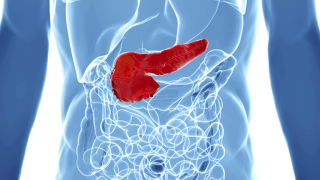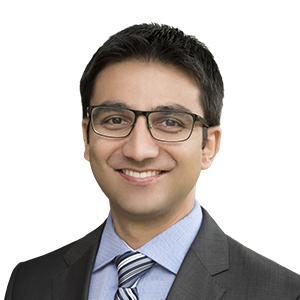Energy, passion and a unique talent for both surgery and science have launched a notable medical career for Mustafa Raoof, M.D., M.S., a surgical oncologist and researcher specializing in gastrointestinal cancers at City of Hope.
For any young scientist, winning a prestigious research award would be impressive, but Raoof has just won two: a Pancreatic Cancer Action Network Career Development Award (PanCAN) and a Young Investigator Award from the National Comprehensive Cancer Network (NCCN).
“I’m very humbled and honored that they saw something in what we were doing and that our research focus is of interest,” he said.
It’s no surprise that his work has garnered such attention — it’s part of a completely novel approach to one of the deadliest diseases, pancreatic cancer.
“It’s one of the hardest cancers to treat because for the majority of patients survival is very limited, and we must develop new therapies,” he said.
The grants will allow Raoof to study two new approaches to treating this disease, and we spoke with him about the innovative science behind his work.
A Unique Vulnerability in Replication
Pancreatic cancer cells are masters of survival, replicating and proliferating even after treatment has severely damaged them. In fact, they often become stronger as a result. But within this process lie the seeds of their own destruction — and that’s what the PanCAN study will explore.
In order for cells to replicate, they must first copy their DNA. This requires a set of special molecular machines, consisting of dozens of proteins that attach to and run along the template DNA like a zipper to read the genetic code and copy it with high accuracy.
On their course along the DNA, the replication machines encounter a different set of molecular machines involved in an equally essential but separate process called transcription. The transcription machines copy the message stored in the DNA to a messenger RNA, which ultimately is used to generate the proteins needed for various functions in a cell.
But here’s the vulnerability — those two machines can crash into each other.
“The transcription machinery is 100 times slower than the replication machinery,” Raoof explained. “When they collide, it’s like a speeding car hitting a pedestrian, and it can cause serious damage.”
Escalating that damage could be one way of treating cancer — but it’s only half the story.
“We've had chemotherapies that inhibit replication for a long period of time, only to have the cancer return. So only targeting the replication process is not enough,” Raoof said. “What is exciting is to understand how cells resolve these collisions, because not much is known about that.”
Because cancer replicates constantly, collisions are so frequent they should be lethal to the cells — but they also have ways to avoid such collisions. Normal cells do too, but don’t often use them, so targeting the collision avoidance mechanisms could be deadly for cancer cells, while not harming healthy cells.
To make this distinction clear, he used this analogy.
“Think about traffic signals in a deserted town with few cars or pedestrians. Even though the signals will prevent collisions, there’s less of a need for them,” he explained. “But if you remove the traffic lights in Manhattan or L.A., you can imagine the consequences. It’s the same with cancer cells.”
Raoof’s study will probe the mechanisms pancreatic cancer uses to resolve the collisions, in order to learn how to block them — in other words, to shut off the traffic lights. If he can do this, the collisions will escalate, and the DNA damage will not only be lethal to malignant cells, but would prevent them from replicating.
His specific aim is to discover which types of cancer cells are most dependent on the collision-avoidance mechanisms, as well as which proteins in those mechanisms would respond to drugs.
Studying a First-in-Class Drug
The NCCN study builds on proof-of-concept research Raoof recently completed with Linda Malkas, Ph.D., dean of translational research and the M.T. & B.A. Ahmadinia Professor in Molecular Oncology at City of Hope. The results of that study, published in Molecular Therapy Oncolytics, showed that targeting a replication and repair protein known as proliferating cell nuclear antigen (PCNA) can kill pancreatic cancer cells in lab models.
Their research proved that a lab-made substance called R9-caPeptide disrupts the interactions between PCNA and its binding partners — a disruption that was toxic in cancer cells but not in normal cells.
However, R9-caPeptide cannot easily be transformed into a drug, and in a companion study Raoof substituted a new drug, AOH1996, developed by Malkus at City of Hope. It’s a small-molecule inhibitor that binds to PCNA and has had promising results with other types of cancer, such as breast cancer. This study showed that it can also be effective against pancreatic cancer, and the results will appear in a soon-to-be-published paper.
But further study is needed, and that’s what the NCCN will cover.
“In cancer nothing is 100%, so AOH1996 works in some cell lines and models but not others,” he said. “So this research will explore exactly how and why it does or does not work.”
The Man Behind the Science
Raoof is one of the few surgeons worldwide who also does basic science research. His motivation for this dual career is clear when you understand what made him decide, when he was quite young, that he wanted to become a doctor.
His mother was a gynecologist, and when she discussed her work, what interested him most was the surgery she performed to remove tumors.
“We would frequently run into her patients when we went out,” he said. “They were always so thankful and appreciative. I realized that to alleviate someone’s suffering is a remarkable blessing.”
In medical school, he became fascinated with surgery — but he was also interested in the process of basic scientific discovery, a career option that did not really exist in his native Pakistan.
He knew that if he wanted this unusual dual career, he would have to continue his studies in the U.S., where among his educational credits are a surgical internship at Yale University Medical School and a postdoctoral fellowship at Harvard.
In his career as both a surgeon and scientist, each discipline contributes to the other. “It allows me to focus on improving cancer care, while drawing inspiration from patients braving their cancer journey,” he said.

